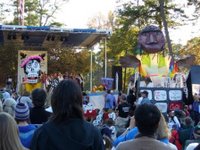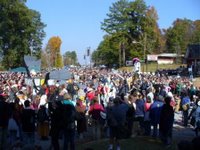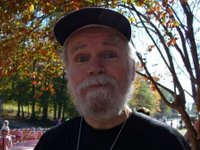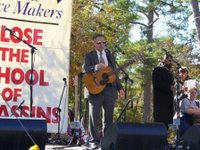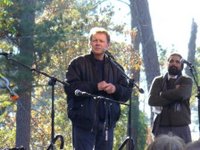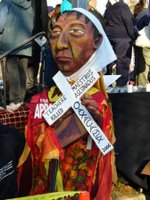



Two nights ago my friend Rick and I had the opportunity to see the
International Contemporary Ensemble perform
Luigi Nono’s rarely-presented 1966 piece
a floresta é jovem cheja de vida (“the forest is young and full of life”), for soprano, three reciters, clarinet, six percussionists (playing bronze metal sheets), and ten-channel tape playback.
The concert took place at the
Chicago Museum of Contemporary Photography in conjunction with an exhibit by
An-
My Lê.
Lê’s work consists of photos of people re-enacting Vietnam war scenes and, in another series, shots of “
29 Palms,” the fake Iraqi village (and environs) constructed in the southern California desert for Marine Corps training;
it’s a twenty-four-hour-a-day theatrical pageant, complete with anti-American graffiti on the buildings and delivery trucks turning out to contain bombs that, in fact, destroy sections of the base. Very weird.
More impressive to me is Martha Rosler’s photomontage series Bringing the War Home (in two phases, one from the Vietnam era and one focused on Iraq, and especially Abu Grahib). Rosler’s collages juxtapose often brutal war imagery with scenes of comfy middle-class domesticity. Doesn’t sound that original, but these constructions are somehow absolutely irony-free; the war doesn’t just make suburban materialism look bad—it actually seems to invade it, suffuse it with horror and mournfulness. Especially in series, these pieces took my breath away.
In any case, I’d heard Nono’s piece on recordings before, and had been pretty baffled (though I loved it, as I do nearly all of his music). Hearing it live, with the percussionists and reciters in one small gallery, the soprano and clarinet in the next room, and the speakers distributing their performances and the prerecorded tracks throughout the composite space, blew me away. Nono’s settings of the live texts (quotations from NLF members, Angolan guerillas, Castro, and others, ending with the repeated question—a quote from a demonstrator in Berkeley—“Is this all we can do?”), always had an interesting relation to the language; the point is clearly neither to musically intensify the meaning (as if unmediated by words) nor to ironize anything (two bad approaches to text-setting in contemporary music).
More than any other music I’ve heard, Nono’s clears out the workings of my perception in a very concrete way. For at least a couple of hours after hearing it, I could hear multiple simultaneous conversations and understand them; sounds and seen things had a distinctness they don’t usually have. Daily experience tends to blur and blend, to encourage habitual perception, and Nono counters that in an astonishing variety of ways throughout his compositional career (especially in his last works). The combination of Marxism and concrete phenomenological intervention—who could ask for more from a composer? Thanks to the ICE for doing it, and for doing it so damn well.
Labels: music
